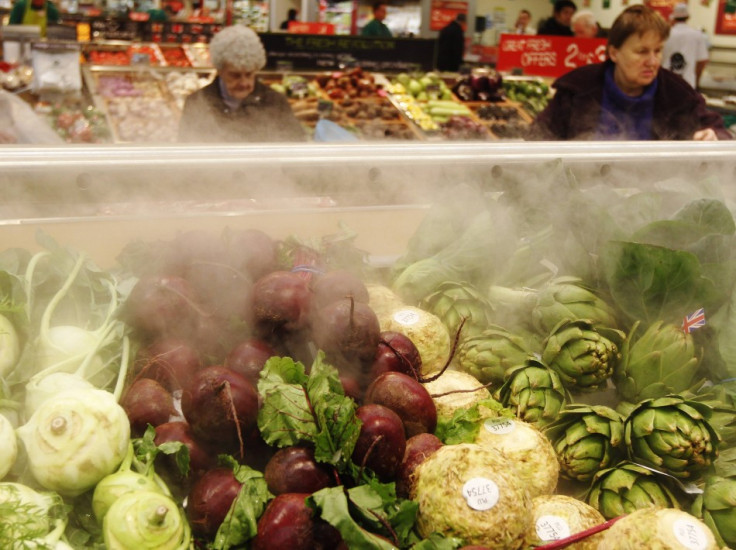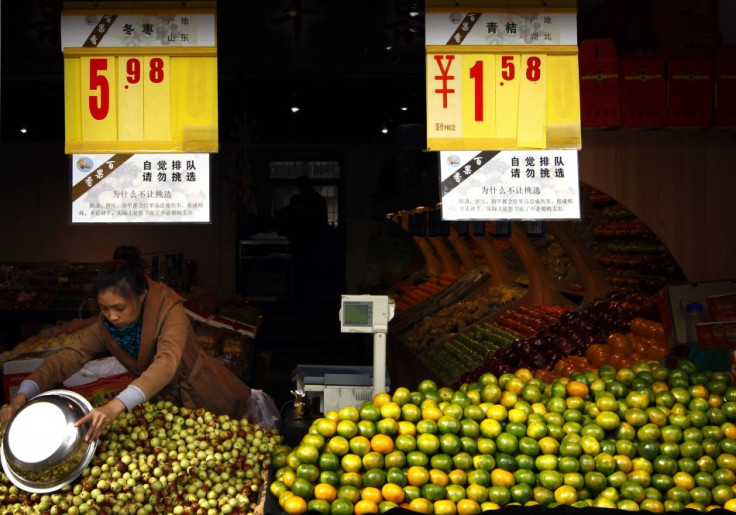Why China's Explosive Economic Growth Could Trigger a Global Food Crisis

As the global population heads towards a projected 9.1 billion by 2050, the availability and cost of food are likely to pose major challenges for countries around the world.
World food prices and the cost of grain increased by 7 percent and 12 percent respectively over the year to the end of 2012. This has happened without any major food crisis or panic policies on the part of major food grain producers.
According to an estimate by the United Nation's Rome-based Food and Agricultural Organisation (FAO), global food production must rise by 70 percent to meet the requirements of 2050 and feed the world's growing number of hungry mouths.
Echoing the sentiment, the US National Intelligence Council's (NIC) Global Trends 2030 report also estimates an increase of at least 35 percent in food demand over the next two decades.
An uncontrollable spike in food prices can lead to increased poverty, deteriorating global health and even tension between nations.
In 2008, a dramatic surge in food prices caused social unrest in various parts of the globe including Egypt, the Ivory Coast, Senegal, Yemen and Mexico, prompting UN Secretary General Ban Ki-Moon to warn that a food crisis could become a serious threat to international security.
Speaking to IBTimes UK, Camilla Toulmin, director of the International Institute for Environment and Development (IIED) agreed that food and water shortages could cause nations to fall out.
"Shifts in power between different countries can generate instability - look at the Nile, where Egypt has for long been the dominant power. This has now been challenged by Ethiopia, as they now have the means to build a dam in the Upper Blue Nile."
The implications of a food crisis are closely linked to another issue that has the potential to threaten global food security - the falling amount of land that is suitable for food production.
As developing countries strive to push their economies forward, land becomes a scarce commodity. Building more factories and cities may result in stronger GDP numbers, but the urbanisation, rising disposable income and population growth such development produces all contribute to rising demand for food.
"Up to 30 million hectares of farmland is lost annually due to environmental degradation, conversion to industrial use or urbanisation," notes Olivier De Schutter, United Nations Special Rapporteur on the Right to Food in a report.
China is one of the best examples of this. The country's population is set to level out slightly by the middle of the century, but its accelerating economic expansion is increasingly destabilising the food balance.
China's Land Shortage
It may seem curious to suggest that the world's fourth largest country has a land scarcity problem, but not when you consider the demographics. This is a country with 20 percent of the world's population but only 9 percent of its farmland and 6 percent of its water resources.
In terms of cereals such as rice and wheat, China has so far managed to satisfy its needs with domestic output and limited imports. But the changing economic situation has resulted in a shift in people's lifestyle.
Improved salaries have raised disposable income, which in turn has pushed up demand for protein-rich foods such as meat and soybeans. A jump in meat production will directly cause an increase in demand for grain to feed the animals.
"China is largely self-sufficient in food production. Not including soybeans, China's self-sufficiency rate for corn, rice, and wheat is about 98 percent or more," Kevin Chen, Senior Research Fellow at The International Food Policy Research Institute (IFPRI) in Beijing told IBTimes UK.
"However, with its environmental stress (particularly on water and land degradation) and increasing urbanisation with new demographic reality in rural areas, to remain self-sufficient at 98 percent will be challenging for China."
As the International Monetary Fund (IMF) notes, "Strong food demand from emerging economies, reflecting stronger per capita income growth, accounts for much of the increase in consumption. Although demand growth has been high for some time now, the recent sustained period of high global growth contributed to depleting global inventories, particularly of grains."
Though rising demand is yet to reach alarming levels, China may soon confront a different problem: a reduction in arable land due to industrialisation and urbanisation.
According to a report by the Vancouver Sun, every year China loses about a million hectares of agricultural land to urbanisation - the country's emerging cities have eaten away about nine million hectares of land between 1996 and 2006.
Coupled with this, marginal land that can be used for farming is being threatened by pollution from China's booming industrial sector, although China is not very open on this matter. The results of soil contamination tests conducted by the Ministry of Environmental Protection and the Ministry of Land and Resources in 2010 remain undisclosed.
The issue of ecological protection was given strong emphasis in the country's recently concluded 18th Party Congress. Officials promised to improve environmental assessments, and increase responsibility and awareness among people about the effects of pollution.
On top of these problems, China also has to face the prospect of a looming water shortage. According to the United Nations, China is one of 13 nations that are experiencing extreme water shortages. Persistent droughts have affected the country's key arable regions such as Shandong province, which produces most of its grains.
The Chinese government knows that food scarcity could be a major problem. In fact, avoiding a hunger crisis will be a top priority for the administration since memories of the terrible famine that killed nearly 50 million people during Mao Zedong's ill-fated Great Leap Forward remain strong in the country's collective consciousness.
To improve farming productivity, authorities have introduced many strong reforms over the last 30 years. These include combining small family-owned land holdings with large scale agricultural areas as well as the mechanisation of production to improve quality. By 2020 China's agricultural production is expected to be 26 percent higher than it is today.
But all this may not be enough, as China's urbanisation rate is expected to rise by 1 percent annually. The government is encouraging people to move to the cities to improve their living standards and boost the economy, even if inflation fears persist.

Imports and Overseas Farmland Takeovers
China has long restricted its food imports to limited quantities of high-quality rice, wheat and corn, placing the emphasis on self-sufficiency. Official policy still mandates that 95 percent of these three staple crops should be produced locally.
At the same time, the country is already the second largest importer of rice in the world, among the top 10 and 20 buyers of corn and wheat, and the biggest importer of soybeans. Chinese rice imports have increased about fourfold this year, and in November it signed a memorandum of understanding with Thailand to import more. Analysts expect the figures to jump further as the economy grows.
China is also the biggest importer of American agricultural products, and a major buyer of Australian meat and wine.
However, the government is well aware that reliance on imports is not sustainable. Trade is often dependant on a number of factors such as the nature of bilateral relations with the importing nation and the geo-political situation in the exporting country. For this reason, China's state-owned and private agricultural companies are actively buying and investing in arable land across the globe.
China has recently become one of the main buyers of agricultural land worldwide, from the Americas to the Asia-Pacific. In Africa, the Communist nation is reported to have set up more than ten research stations to increase production of staple crops.
It is thought to have spent billions of dollars acquiring millions of hectares of arable land in North and South America, Central Asia, Africa, Australia and New Zealand.
Despite wide criticism of China's acquisition of land, Beijing has so far been able to continue with its plans.
A Food Crisis Looming
China's scramble to secure food for its people clearly indicates that its leaders realise the gravity of the threat. But while the Chinese government may be able to maintain a good supply, the shifting nature of Chinese food consumption and rising demand could lead to a global rise in food prices.
It is also possible that exporters will shift production from traditional crops to those in demand in China, thus indirectly pushing up the prices of other crops. For example, rising demand for soya could prompt farmers to cultivate more of it, potentially leading to price hikes for other crops.
But a crisis could be averted if China were to adopt better approaches to agriculture and self-sustainability. According to NIC, innovation in crop genetics and technological advances promise sustainable systems of farming. Robotics could aid in conserving water and fertiliser, resulting in improved efficiency. Improved irrigation systems could further help save resources.
The real issue, then, is not about the ability to reach self-sufficiency, but about the willingness to do so. If the Chinese government decides that it is more beneficial to import than to produce, it might buy more, rather than less.
China does not need to be independent in this matter, says Harold Corke, a professor at the University of Hong Kong's School of Biological Sciences.
"Because China is economically prosperous, and exporters have capacity for further expansion of grain and soy production (such as Brazil, Argentina, and the US), I think that China has no need or rationale for self-sufficiency in all food categories," Corke told IBTimes UK.
Wherever its food comes from, China needs to maintain stability to avoid a global food crisis.
© Copyright IBTimes 2025. All rights reserved.





















